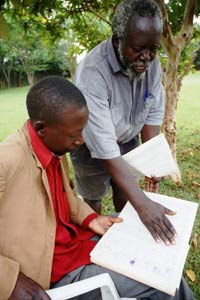CIMMYT E-News, vol 4 no. 1, January 2007
 Farmers and community leaders in Kenya’s most densely-populated region have organized to produce and sell seed of a maize variety so well-suited for smallholders that distant peers in highland Nepal have also selected it.
Farmers and community leaders in Kenya’s most densely-populated region have organized to produce and sell seed of a maize variety so well-suited for smallholders that distant peers in highland Nepal have also selected it.
According to Paul Okong’o, retired school teacher and leader of Technology Adoption through Research Organizations (TATRO), Ochur Village, Western Kenya, farmers first disliked the maize whose seed he and group members are producing. “It has small grains, and they thought this would reduce its market value,” he explains. “But when you sowed the seed, which looked small, what came out of it was not small!”
Small-scale maize farmers of the Regional Agricultural Association Group (RAAG), another community-based organization in Western Kenya, have quintupled their yields in only one year—now obtaining more than 2 tons of maize grain per hectare—using seed, fertilizer, and training from TATRO, according to RAAG coordinator, David Mukungu. “This has meant that, besides having enough to eat, farmers were able to sell something to cover children’s school fees or other expenses,” says Mukungu. “We started with six farmers the first year, but after other farmers saw the harvest, the number using the improved seed and practices increased to thirty, and we expect it will continue increasing.”
The variety whose seed TATRO grows is called Kakamega Synthetic-I. It is an open-pollinated variety—a type often preferred over hybrids by cash-strapped smallholders, because they can save grain from the harvest and sow it as seed the following year, without losing its high yield or other desirable traits. The variety is also drought tolerant, matures earlier than other local varieties, and is better for making Kenyan’s favorite starchy staple, ugali. “Women say it ‘pulls’ the water, which means you don’t need much maize flour to make a good, heavy ugali,” Okong’o explains. “These things seem small, but when taken together they weigh a lot for farmers who eat ugali as a daily staple.”
A maize that crosses many borders
Kakamega Synthetic-I was released by the KARI research station in Kakamega, Kenya. Its pedigree traces back to the work of CIMMYT and many partners in southern and eastern Africa—national maize research programs, private companies, and non-government organizations—to develop stress tolerant maize for the region’s smallholders. “Kakamega Synthetic I was selected from ZM621, a long-season, drought tolerant, open-pollinated variety now released in several African countries,” says Marianne Bänziger, CIMMYT maize physiologist who took part in the creation of ZM621 and now serves as director of the center’s Global Maize Program. “The variety has also been released in Nepal, after small-scale farmers from the mid-hills chose it as one of their favorites in participatory varietal trials.” Bänziger says. This highlights the role of a global organization like CIMMYT, which can draw upon and distribute public goods and expertise transcending national borders: “The center was predicated upon and has practiced collaborative science ‘globalization’ for agricultural development since its inception four decades ago—long before that term became fashionable in policy circles.”
Finding and filling entrepreneurial niches
By reducing risk for small-scale farmers, varieties like Kakamega Synthetic-I encourage investment in other amendments, like fertilizer, that can start smallholders on an upward spiral out of low-input, subsistence agriculture. Good varieties also entice enterprising farmers and community-based organizations like TATRO into potentially profitable businesses like seed production, for niches inadequately served by existing companies. “We observe the seed production regulations of the KEPHIS, the Kenyan plant health inspectorate, and would like to work toward certification of our organization, to be able to sell certified seed in labeled packages and fetch better prices,” says Okong’o. TATRO is currently producing and marketing just under 2 tons of Kakamega Synthetic-I—enough to sow more than 70 hectares—each year. The lack of effective informal seed production and distribution systems limits the spread of improved open pollinated maize varieties and farming practices in eastern Africa, according to Stephen Mugo. CIMMYT maize breeder in the region, Mugo also coordinated the former, Rockefeller Foundation-funded project “Strengthening maize seed supply systems for small-scale farmers in Western Kenya and Uganda” that involved TATRO and similar farmer organizations. “Improved varieties raised yields in the past and could do so again,” he says, “but only about one-fifth of the region’s farmers grow improved varieties.”
For more information, Stephen Mugo, maize breeder (s.mugo@cgiar.org)
 Capacity development
Capacity development